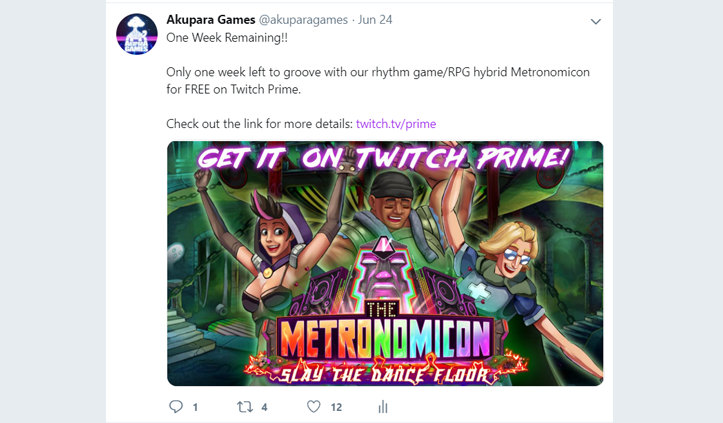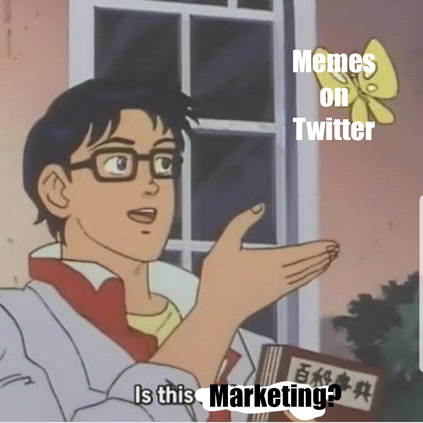How to optimize Twitter for indie game marketing
Say for the sake of argument, you’re an indie game company about to crack into the next phase of your development pipeline. You’ve been hitting milestones dead center, you’re on your beta, you’re planning your tour of the big conventions and everything in between. Now, maybe you have a publisher like Akupara Games that’s going to handle this stuff for you. But maybe you’re going it alone, ready to brave the big, bad indie game marketplace and make your mark.
You’re going to want to make a Twitter account.
Now, you’re going to want Facebook, Instagram, a subreddit and everything else, and I’ll be covering those pieces of the social media-sphere in future blogs. But for now, let’s focus on the 280 character behemoth that is Twitter. Of all our social media presences, Twitter is by far the most engaged and active. We post daily updates to the account, which is more than any other social media site (except the company Discord, but let’s compartmentalise that kind of IM service for now.) But more importantly, the translation from views to clicks to engagements for Twitter makes it much stronger than our other platforms. The secret to that success? Variety.
Over the past few years, we have seen Twitter as a marketing platform transform into a wide variety of different contexts. In my experience, those contexts are: specific advertising, abstract branding, and unrelated meming. You might read advice from other blogs to focus your account on one of those contexts at the exclusion of the other, but I don’t like zero sum games. Let’s run the table. Instead, let’s do all of them together. Starting with the most straightforward.

Advertising
The Home Depot’s Twitter account posts sales, specific services and highlights products. In short, they use Twitter to advertise. Now, this might seem obvious but I want to lay it out piece by piece. Posting ads on your Twitter page is the way that your page translates into sales. You advertise something, your audience clicks the ad, buys the product, transaction completed. Here’s the problem, though. If you’re just starting out your development process, even if you have other games to market, those ads get old pretty quick. People have seen you tell them to buy your game. They’ll see it a ton more. You either post once every few weeks so as not to blow up their feed with “buy my game” or you post “buy my game” every day and people unfollow you for the spam. Home Depot can get away with it since they’re selling eight hundred thousand different products. Indie devs like us can’t. In other words, it’s absolutely imperative to post ads in order to transition your Twitter presence into sales, but flooding the market with them will drive away followers, causing people not to pay attention to you.
Branding
OK, but let’s say you’re not Home Depot. There are plenty of niche products on Twitter that fill their feeds with something. What could that be? Well, Cheerios (I’m being so serious here) is actually a great example. It’s one product. Not only that, it’s one product that most people will buy on a regular trip to the grocery store, not in an online sale. If Cheerios has a Twitter, what does it do all day? The answer is branding. Cheerios will create content for Twitter, content entirely unrelated to their product, and post it. The goal is to create a brand identity and association. For Cheerios, it’s wholesome, family oriented content. Songs about teaching kids kindness and to share, Charity drives, and image captured from classic children’s cartoons. Cheerios finds and creates content about their brand and the things that they’d like to people to associate with it and posts that content to Twitter. Not to get meta about it, but I tweeted this article out. I’m not looking to make a sale by posting this, I’m looking to help indie devs get a crash course in marketing on Twitter. But tweeting about it creates a brand, that Akupara Games wants to help indie devs thrive. Finding the right products to associate yourself with, creating the content that helps people remember you? That’s branding. Just as a note: the very best branding tool that I’ve found is fan art. Find it. Post it. Credit the artists. It’s the gift that keeps on giving.
Memes
Alright, let’s be real. The minute I started talking about Cheerios and Home Depot, you knew were going to end up here. Memes. It’s something that’s been infecting official Twitters for a while now, whether it’s Wendy’s roasting folks or Discord oblivious to its own functionality. Advertising translates your Twitter following into sales. Branding helps create positive associations with your product. Memes are all about attention. When something is funny or witty or clever, that retweet button and that like button gets hit. But, crucially, the engagement that comes from it comes from people that don’t engage in your Twitter in other ways. Put another way, memes capture an audience that branding and advertising don’t hit. They’re not interested in buying something, they’re not interested in your other content, they’re just interested in scrolling through their feed and retweeting things that make them giggle. And when they do, you’re getting new eyeballs on your timeline, profile, ads and branding.

Variety
The secret to using Twitter effectively as an indie game dev studio is all three. There are going to be times when you’re pushing sales or wishlist campaigns and you’ll need to build up ads for that. There are going to be times when you have fan art to feature or a cool partnership that you want your audience to know about. You’ll need branding for that. And there are going to be times when you have absolutely nothing at all to post, so you look at what’s trending and write a meme about it. And the reason this worksis breadth. Your ads are going to hit one audience, branding another, memes a third. That’s perfect. It widens the scope of your engagement and grows your audience in natural, organic ways.
If you want to see our Twitter philosophy in action, follow us here. You can also join our Discord if you have any questions or comments about this article.
